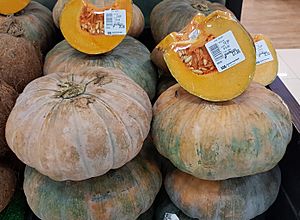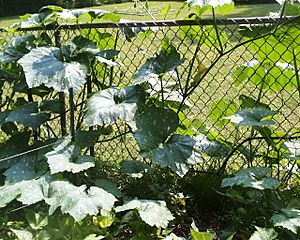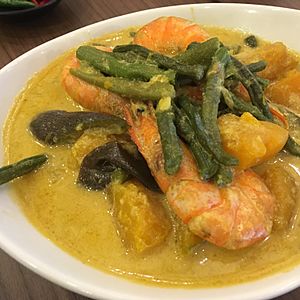Calabaza facts for kids


Calabaza is a Spanish word for any type of pumpkin. In English, it usually means what is called the West Indian pumpkin. This is a type of winter squash grown in warm places like the West Indies, tropical America, and the Philippines.
Calabaza is the common name for Cucurbita moschata in places like Cuba, Florida, Puerto Rico, and the Philippines. In the Philippines, it's also spelled kalabasa. This squash is known by other names too, such as auyama in the Dominican Republic, ayote in Central America, and zapallo in South America.
Contents
What's in a Name?
The word "calabaza" comes from the Spanish language. The English word "calabash" is also related to it. It came from the French word calebasse, which was based on the older Spanish term.
Different Kinds of Calabaza
In North America, the word calabaza can refer to several types of squash from the Cucurbita family. Most often, it means types of Cucurbita moschata, which first grew in the Caribbean.
The skin of these squashes can be dark green to light yellow. The inside flesh is usually bright orange or yellow. Different types have slightly different tastes and textures. But generally, they are a bit sweet and have a firm but soft texture.
How Calabaza Plants Grow
Calabaza plants have both male and female flowers on the same plant. Insects like honeybees help pollinate them. The plants have long vines that can grow up to 15 metres (50 feet) long. Some types grow more like bushes.
A single plant can produce between two and fifteen fruits. The bush types usually produce more. A calabaza fruit can weigh from 2 to 23 kilograms (5 to 50 pounds). Their shape can vary a lot, from oval to round, pear-shaped, or flat.
When the fruit is young, its skin is light to dark green. As it ripens, it turns light orange to beige. The skin can be smooth or bumpy. The inside flesh is green-yellow to orange and is about 3 to 8 centimetres (1 to 3 inches) thick.
How People Use Calabaza
Calabaza is used in many different dishes. People eat it in stews, cakes, and even candies. It can also be used in recipes instead of other types of pumpkin. It has a smooth and somewhat sweet taste. Calabaza is a good source of beta-carotene, which your body can turn into vitamin A.
Because of Spanish influence, C. moschata became very popular in the Philippines. There, it's known as kalabasa and is a common vegetable in many dishes.
The flowers of the calabaza plant are also eaten. In Mexican cuisine and New Mexican cuisine, flor de calabaza (calabaza flower) is used in quesadillas and empanadas. In Salvadoran cuisine, it's used in pupusas. In Filipino cuisine, the flowers are often stuffed or added to soups, along with the young leaves.
The seeds of the calabaza, called pepitas, are also a popular snack. They are often toasted and seasoned.
See also
 In Spanish: Calabaza para niños
In Spanish: Calabaza para niños


